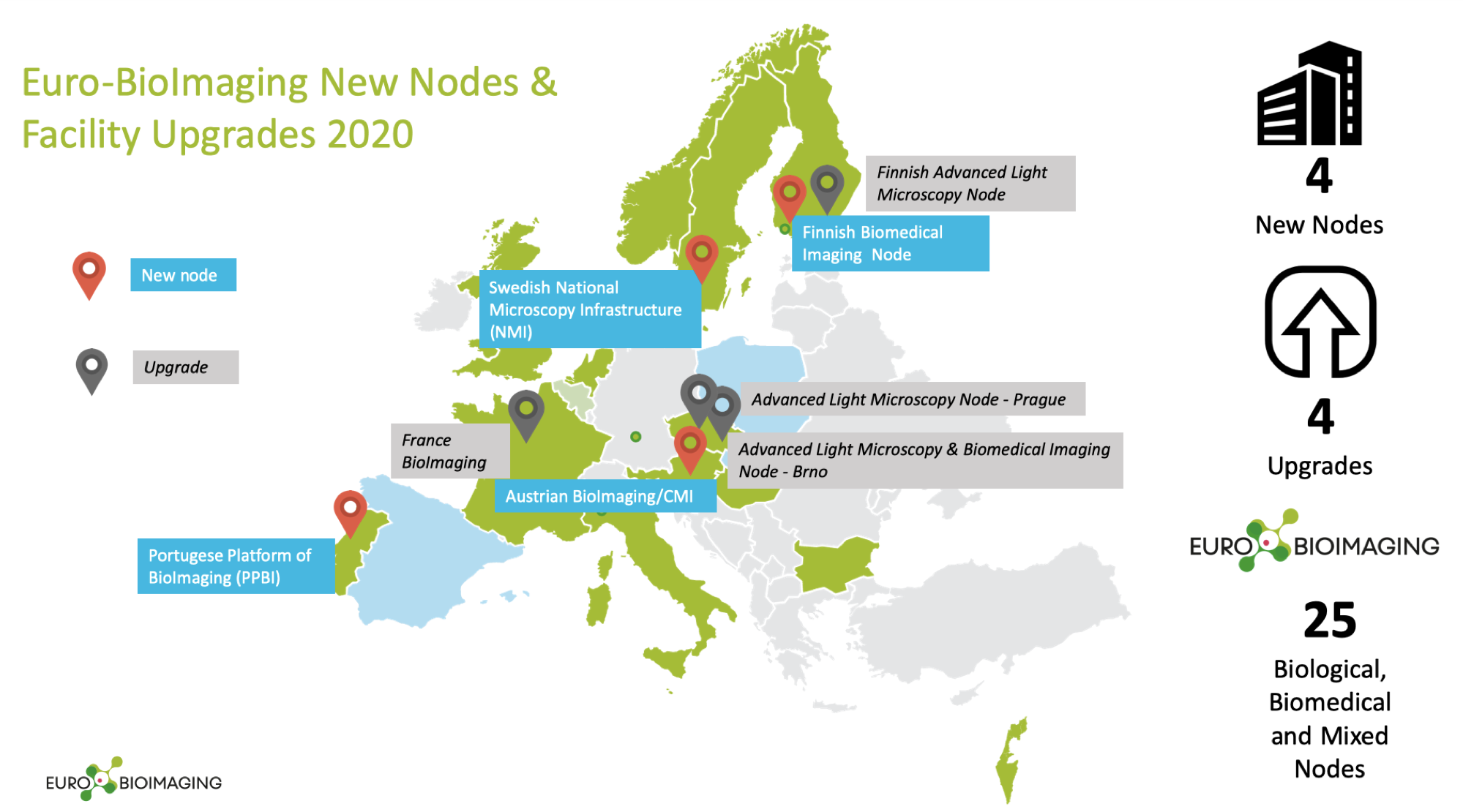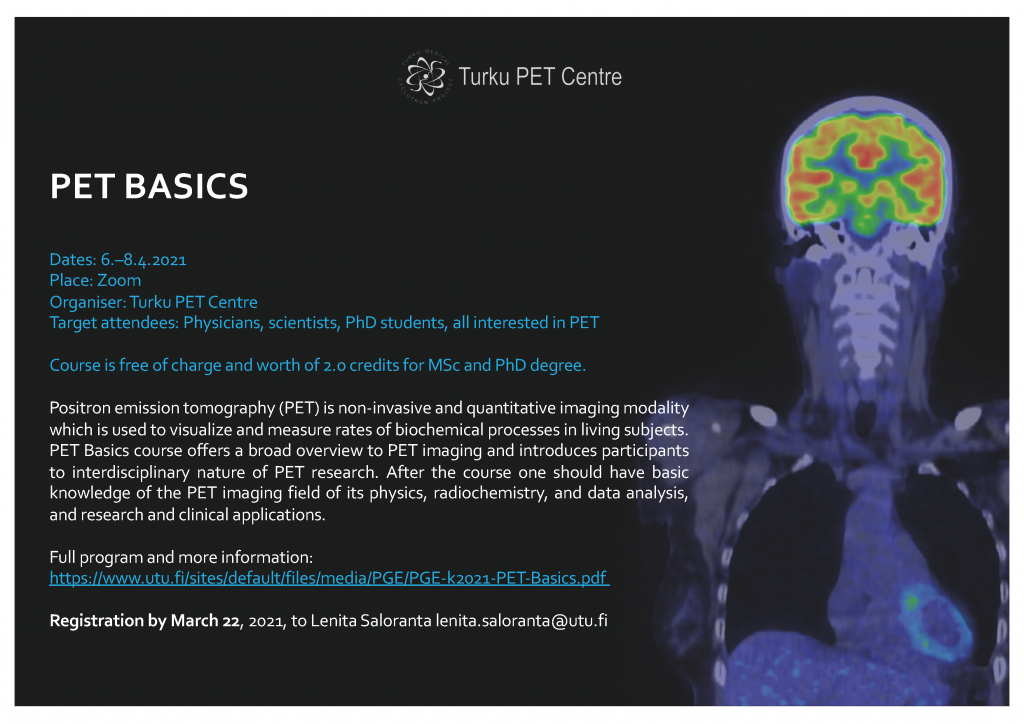We are very pleased to announce that the Euro-BioImaging family is growing! In 2020, we welcome four new Nodes hosted by Austria, Finland, Sweden, and Portugal. These include two Biological, one Biomedical and one Mixed Node. Four existing Nodes were also granted upgrades, bringing on board new facilities and expanding their technology portfolio.
A cutting-edge infrastructure
These renowned imaging facilities have undergone a stringent, independent review process by the Euro-BioImaging Scientific Advisory Board (SAB) that ensures that only the most advanced imaging facilities with a cutting-edge and diverse technology offer become Euro-BioImaging Nodes.
As part of the Euro-BioImaging research infrastructure, the services provided by these facilities will be open to all scientists, regardless of their discipline or affiliation. We congratulate the successful new Nodes and upgraded Nodes and look forward to sharing more news about these imaging facilities in the upcoming months.
Some of the applications from this year’s Call for Nodes are still being processed, and Euro-BioImaging hopes to be able to welcome even more new Nodes or Node upgrades in the first half of 2021.
How does an imaging facility become a Euro-BioImaging Node?
Between April and June 2020, in this year’s call for Nodes Euro-BioImaging invited applications from imaging facilities located in Euro-BioImaging ERIC member countries who wanted to become a Euro-BioImaging Node. In addition, existing Euro-BioImaging Nodes could apply for an upgrade to include new facilities within their Node structure.
Stringent requirements
The applicants compiled detailed information about their facility and included letters of intent from prospective international users. The SAB reviewed all eligible applications and made recommendations, based on demonstrated excellence in the following areas:
- Technology offer
- User access management plan
- Training plan
- Image data management plan
- International relevance
- Maturity of the service offer
Four new Node candidates were recommended or even highly recommended for inclusion into the Euro-BioImaging research infrastructure. Four of the applications for upgrades of existing Nodes were also recommended or highly recommended by the SAB.
The recommended candidates were ratified by the Euro-BioImaging Board, which comprises the representatives of the 15 Euro-BioImaging Member Countries and EMBL, on November 30th, 2020. Preparations are now underway to enable users to apply to the new Nodes and upgraded Node technologies as soon as possible.
Meet our New Nodes & Learn about Upgraded Facilities

BIOLOGICAL NODES:
PORTUGAL: Portuguese Platform of BioImaging (PPBI)
The new Portuguese Platform of BioImaging (PPBI) Node is a multi-sited, multimodal Node covering biological imaging. PPBI represents the national biological microscopy imaging community of Portugal. It consists of 14 facilities, which are split into 3 geographical clusters, and are currently coordinated by the IBMC (Instituto de Biologia Molecular e Celular) in Porto. PPBI services focus on advanced microscopy and image data analysis for a wide range of life science domains – from cell and developmental biology, to neurosciences, oncobiology, immunology, infection, and regenerative medicine.
Learn more – https://www.ppbi.pt/joomla30/
SWEDEN: National Microscopy Infrastructure (NMI)
The new Swedish National Microscopy Infrastructure (NMI) Node of Euro-BioImaging is a multi-sited, mulitmodal Node covering biological imaging. NMI was created as a distributed national infrastructure in 2015/2016 after nominations of facilities from Swedish universities followed by an international evaluation and selection process. It consists of five, specialized, complementary, and interlinked sites and one administrative host, all located across Sweden. The mission of NMI is to provide faster access to innovative technology and competence in microscopy and image analysis for the life science research community. The infrastructure is coordinated by KTH (Royal Institute of Technology) which provides the single-entry point from which users are directed to the relevant imaging technologies.
Learn more – https://nmisweden.se/
BIOMEDICAL NODE:
FINLAND: Finnish Biomedical Imaging Node
The new Finnish Biomedical Imaging Node is a multi-sited, multimodal Node covering biomedical imaging from mouse to man. The proposed Node is made up of 4 partner institutions who formed the Finnish Infrastructures for Functional Imaging in 2013, each specializing in a certain spearhead technology with service offerings for supporting technologies. The available imaging modalities include preclinical and clinical positron emission tomography (PET), preclinical high-field magnetic resonance imaging (MRI), magnetoencephalography (MEG), and preclinical optical intravital imaging.
Learn more – http://neuro.hut.fi/fifi/
MIXED NODE:
AUSTRIA: Austrian BioImaging/CMI
The Austrian Bioimaging Node CMI is a multi-sited, multimodal Node covering biological and biomedical imaging modalities up to the preclinical level. This Node represents the National Imaging Community of Austria, which has been operational since 2016. It is hosted by 8 leading institutions across the country with a broad service offer for both biological and biomedical imaging. Imaging techniques at Austrian BioImaging/CMI span the entire resolution range of interest for (pre)clinical and biological studies, and provide complementary sample information about structure, function, dynamics and chemical composition. More than 35 imaging techniques allow both in- and ex-vivo imaging and molecular analysis. The new Node is specialized in the development of advanced multimodal workflows at the forefront of correlated imaging, which can involve more than two imaging modalities – and hence significantly advances the field of correlated imaging with truly holistic approaches.
Learn more – https://www.bioimaging-austria.at/
Learn more about Facility Upgrades:
BIOLOGICAL NODES:
FINLAND: Finnish Advanced Light Microscopy Node – Upgrade
The Finnish Advanced Light Microscopy (FiALM) Node of Euro-BioImaging is multimodal and multi-sited (Turku, Helsinki, and Oulu). It was established in the first Euro-BioImaging Call for Nodes in 2013, based on an existing multi-sited national open access infrastructure. Going forward, the FiALM Node will also incorporate the High Content Imaging and Analysis Unit (FIMM-HCA) at the Institute for Molecular Medicine Finland (FIMM), Helsinki Institute of Life Science (HiLIFE) at the University of Helsinki, Finland, allowing it to offer new expertise in High-Throughput Microscopy.
CZECH REPUBLIC: Advanced Light & Electron Microscopy Node Prague
The Advanced Light and Electron Microscopy Node Prague is a multi-sited, multimodal Node, hosted by 5 facilities in Prague, with a focus on biological imaging. It was established in the first Euro-BioImaging Call for Nodes in 2013. From now on, the existing Prague Node also includes the Laboratory of Electron Microscopy, at the Biology Center of the Czech Academy of Sciences (LEM), located in Ceske Budejovice, bringing on board new expertise in a wide range of electron microscopy methods.
FRANCE: French BioImaging Node – Upgrade
The Bretagne Loire Node became a node of the national infrastructure France BioImaging (FBI) in November 2019. The Bretagne Loire Node brings together four cellular imaging and histology facilities, two in Rennes (MRic and H2P2) and two in Nantes (MicroPIcell and APEX). These facilities have complementary expertise for live imaging and pathological anatomy. These facilities will now be open to Euro-BioImaging users as part of the French BioImaging Node of Euro-BioImaging.
MIXED NODE:
CZECH REPUBLIC: Advanced Light Microscopy & Medical Imaging Node Brno
The Advanced Light Microscopy & Medical Imaging Node Brno, already a multi-sited, multimodal Node which offers both biological and biomedical imaging services, is bringing on board a new imaging facility – the Experimental Biophotonics Facility at the Brno University of Technology. With this addition, the Brno Node is able to offer the new imaging technology of holographic incoherent quantitative phase imaging in correlation with laser scanning confocal microscopy to Euro-BioImaging users.

